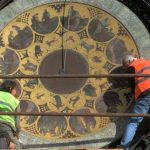Tangled Up in Robert Morris (1931–2018) – 罗伯特·莫里斯(1931-2018)
I saw my first Robert Morris sculpture eight years ago, around the time I moved to New York. I had recently finished with school and the city was already upending my life. I didn’t know who I was or who I wanted to be. Every object and surface, face and friendship trembled with possibility. Contact with anything or anyone threatened to utterly transform me. This was worrisome. How could I change if I didn’t quite know myself? The Morris sculpture – pinned to a wall in a stranger’s apartment in Chelsea – was grey, velvety, untitled, its date unknown to me; it hung alongside other huge, expensive sculptures and paintings, mostly by artists whose names I recognized from museums. This was not a home where I had ever expected to have dinner, but a friend of a friend was house sitting, so I was invited over for noodles.
robert-morris_by-grant-delin.jpg

Potrait of Robert Morris. Courtesy: © Grant Delin
The house-sitter was a famous writer. He embodied, for me, everything about New York: its fleer of intelligence and wit, its world-weariness, its disdain for downtime and slow talk. And its bigness. I shook in his presence. If everything had as yet offered only its fearsome metamorphotic potential, then here, in this writer, was my Ovid – a magic hand to conjure the changes. It seemed that even his passing glance might render me a tree. Or a writer. Or an artist. Anyone. The choice was his. He roared with ideas, musings, asides. He regaled us with news of the world outside Manhattan, with stories from his recent travels – to Asia and Europe, two continents I had never set foot upon. He knew them well. Before New York, I had lived much of my life in South Carolina, a small state in the southern US, and an unambiguous nowhere, by my esteem.
The writer was on assignment, he told us. He had been tasked with writing about an artist who was soon to have a major retrospective at a great museum in an important city. Maybe it was New York. Maybe it was London. Maybe even Paris. He didn’t say so, but the fee he had secured for the job was a skyscraper-high pile of cash, the can-you-believe-it dollar-amount only whispered about in the city since no one, not anyone anywhere, had ever been paid so much to write about an artist. (Or so my friend whispered to me when the writer slipped into the toilet.) I liked him, but only in the way his large personality seemed to call for: as a character, as a person who had re-invented himself countless times into a figure not for the city’s present, but for its history. He was comic in the old sense of the word. A reveller, or revelator.
Papers, notebooks and catalogues were strewn about the floor, forming around him a bookish pentagram from which he convoked the spirit of Great Literature. I was mostly silent while we waited for our takeout to arrive until finally, at a lull in the writer’s monologue, I ventured to ask: ‘What’s that?’ I nodded toward the Morris behind him, its crumpled, soft form looking, to me, like a deflated balloon.
robert-morris-at-castelli-gallery_1968_01.jpg

Robert Morris’ first exhibition of felt works at Castelli Gallery, New York, 1968. Courtesy: Castelli Gallery, New York
‘That? A Robert Morris,’ he said.
My friend interrupted, ‘You don’t know his work?’ He looked surprised, even embarrassed.
I grew red in the face. Perhaps now the transformative glance would come, and its effect would be a chilling one – poof, and I would devolve into a mess of limbs like that Morris: broken down, useless. Dispatched and then hung dead on a wall, a warning-sign to fellow fools.
‘It’s one of his “tangles”,’ the writer explained. His tone was surprisingly understanding, more so than my friend’s. ‘You’ve probably seen his work. You just didn’t realize.’ He removed his phone from his pocket and called up the 1974 advertisement for Morris’s show at the Castelli-Sonnabend gallery. It shows the artist in an old army hat, his eyes shielded from the camera by huge aviator sunglasses. He’s shirtless, and he holds the leash of a chain bolted around his neck. The sweat of his left arm catches the light; it’s huge and muscular – an arm not of menace or threat or even sex, though it’s those things too, but of authority. It’s the arm of someone who has been changed, who has, through the transmogrifying influence of New York’s downtown club culture become someone new. President Nixon had been ousted, the country was in tatters, sex was back, identity was what you will.
poster_castelli_sonnabend.jpg

Poster for Robert Morris’s 1974 exhibition at Castelli Gallery, New York. Courtesy: Castelli Gallery, New York
(Morris wasn’t gay, though the image trades in the butch aesthetics of the Meatpacking District’s leather clubs, like the Mine Shaft. Once I might have grumbled at this appropriation, but now it strikes me as a savvy nod to gay life’s promiscuous influence on the city-at-large, the freaky coolness of sex.)
I don’t remember how I responded to the image. Perhaps I said, ‘Wow’ – an elastic utterance, itself a burp of change and a harbinger of it. An inverted ‘Mom’, the mama of wonder and confusion.
‘My theory,’ the house-sitter said, ‘is that if you laid out this sculpture, ‘you’d see something.’
‘What would you see?’
‘An elephant. Like Dumbo.’ The eponymous elephant star of Disney’s 1941 feature-length cartoon.
‘Why Dumbo?’
‘Do you remember the scene when he gets high and everyone around him turns to bubbles? This is the bursting bubble made felt and tacked to the wall. A reminder of passing highs, you could say.’
rmo_install_smb_2012_06.jpg

Robert Morris, 2012, installation view, Sprüth Magers, Berlin. Courtesy: Sprüth Magers, Berlin / London / Los Angeles; photograph: Jens Ziehe
The writer was either wrong or playing with me, suggesting only the absurd to see how much of it I would gobble up. All of it, as it turns out, since I sat for the rest of the night, as wine and noodles flowed, concentrating on the deflated elephant on the wall. Its form, like much of Morris’s sculpture, possessed an almost risible, surreal promise, as if at any moment it might fill with gas and become a Really Living Thing. But what, or who?
I saw its limbs inflate, its belly rise, its head take shape. But it was no elephant, it was something – someone – else. It fattened as it continued to climb over our drunken forms sprawled on the floor, among the books and sheets of paper. Its wings and limbs and other loose bits flapped and whipped the air. It threatened to bump the art off the walls, to blow us out the window. It was everything and nothing, completely unrecognizable as any creature or object – a thing only to be awed for its capricious formlessness. It was New York, it was the writer, it was the river out the window, it was a place to stumble into, a being-as-landscape. It was no Dumbo, nor one of Dumbo’s mescaline-dreamt friends, though it was them, too. It could have been me, or Robert Morris. No matter, it never quite cohered. Eventually it returned to its spot on the wall, where it belonged – less sculpture than vision.
Main image: Robert Morris inside Box for Standing, 1961. Courtesy: Castelli Gallery, New York; photograph: © Grant Delin
Andrew Durbin is the author of Mature Themes (2014) and MacArthur Park (2017), both from Nightboat Books. He is a Senior Editor of frieze and lives in New York.
 Robert Morris.礼貌:格兰特·德林.看门人是一位著名的作家。对我来说,他体现了纽约的一切:它的智慧和智慧,它的厌世情绪,它对闲暇时间的蔑视和慢谈。还有它的庞大。我在他面前发抖。如果一切都只是提供了可怕的变质潜能,那么,在这位作家中,我的奥维德就是我的魔手——一只召唤变化的魔手。似乎即使他短暂的一瞥,也可能使我变成一棵树。或者作家。或者是艺术家。任何人。选择权属于他。他吆喝着各种想法、沉思、旁白。他给我们带来了曼哈顿以外的世界新闻,还有他最近旅行的故事——去亚洲和欧洲,这两个我从未涉足过的大陆。他很了解他们。在纽约之前,我的大部分生活是在南卡罗来纳州度过的,那是美国南部的一个小州,毫无疑问,在我看来,这里一无所有。他告诉我们,作者正在执行任务。他的任务是写一篇关于一位艺术家的文章,这位艺术家不久将在一个重要城市的一个大博物馆举行一次大型的回顾会。也许是纽约。也许是伦敦。也许甚至是巴黎。他没这么说,但是他为这份工作所争取的费用是一大堆摩天大楼般的现金,这笔钱——你能相信吗——只在城里悄悄地说了一遍,因为从来没有人,甚至没有人,被付这么多钱来写一个艺术家的作品。(或者当我的朋友悄悄对我说,当作者溜进厕所时。)我喜欢他,但仅仅是因为他那高大的个性:作为一个人物,作为一个无数次把自己重新塑造成一个形象的人,不是为了这个城市的现在,而是为了它的历史。他是个古老意义上的喜剧演员。狂欢者,狂欢者纸张、笔记本和目录散落在地板上,在他周围形成一个书生气十足的五角形,从中他激发了伟大文学的精神。当我们等待外卖到达时,我几乎保持沉默,直到最后,在作者独白的停顿中,我冒昧地问:“那是什么?”我朝他后面的莫里斯点点头,它皱巴巴的、柔软的身影在我看来就像一个放气的气球。罗伯特·莫里斯在卡斯特利画廊_1968_01.jpg
Robert Morris.礼貌:格兰特·德林.看门人是一位著名的作家。对我来说,他体现了纽约的一切:它的智慧和智慧,它的厌世情绪,它对闲暇时间的蔑视和慢谈。还有它的庞大。我在他面前发抖。如果一切都只是提供了可怕的变质潜能,那么,在这位作家中,我的奥维德就是我的魔手——一只召唤变化的魔手。似乎即使他短暂的一瞥,也可能使我变成一棵树。或者作家。或者是艺术家。任何人。选择权属于他。他吆喝着各种想法、沉思、旁白。他给我们带来了曼哈顿以外的世界新闻,还有他最近旅行的故事——去亚洲和欧洲,这两个我从未涉足过的大陆。他很了解他们。在纽约之前,我的大部分生活是在南卡罗来纳州度过的,那是美国南部的一个小州,毫无疑问,在我看来,这里一无所有。他告诉我们,作者正在执行任务。他的任务是写一篇关于一位艺术家的文章,这位艺术家不久将在一个重要城市的一个大博物馆举行一次大型的回顾会。也许是纽约。也许是伦敦。也许甚至是巴黎。他没这么说,但是他为这份工作所争取的费用是一大堆摩天大楼般的现金,这笔钱——你能相信吗——只在城里悄悄地说了一遍,因为从来没有人,甚至没有人,被付这么多钱来写一个艺术家的作品。(或者当我的朋友悄悄对我说,当作者溜进厕所时。)我喜欢他,但仅仅是因为他那高大的个性:作为一个人物,作为一个无数次把自己重新塑造成一个形象的人,不是为了这个城市的现在,而是为了它的历史。他是个古老意义上的喜剧演员。狂欢者,狂欢者纸张、笔记本和目录散落在地板上,在他周围形成一个书生气十足的五角形,从中他激发了伟大文学的精神。当我们等待外卖到达时,我几乎保持沉默,直到最后,在作者独白的停顿中,我冒昧地问:“那是什么?”我朝他后面的莫里斯点点头,它皱巴巴的、柔软的身影在我看来就像一个放气的气球。罗伯特·莫里斯在卡斯特利画廊_1968_01.jpg  罗伯特·莫里斯在纽约卡斯特利画廊首次展出毛毡作品。礼貌:卡斯特利美术馆,纽约“罗伯特·莫里斯,”他说。我的朋友打断了我的话,“你不知道他的工作吗?”他看上去很惊讶,甚至很尴尬。我脸红了。也许现在这种转变性的眼光会到来,它的效果会令人心寒——砰,我会变成一团糟的肢体,就像莫里斯那样:崩溃了,没用了。打发完毕,然后死挂在墙上,这是对愚人同胞的警告。作者解释说,这是他的“纠结”之一。他的语气出乎意料地通情达理,比我朋友的语气还要通情达理。“你大概看过他的作品吧。”他只是没意识到。”他从口袋里掏出手机,在卡斯特利-桑纳本德美术馆为莫里斯的演出打出了1974年的广告。它显示了一个戴着旧军帽的艺术家,他的眼睛被巨大的飞行员太阳镜挡住了摄像机。他没有衬衫,脖子上系着锁链。他的左手臂的汗水闪烁着光芒,它很大,肌肉发达——一只没有威胁、威胁甚至性行为的手臂,虽然它也是那些东西,但具有权威性。它是一个已经改变的人的手臂,通过纽约市中心俱乐部文化的蜕变影响,他已经变成了一个新人。尼克松总统被赶下台,国家支离破碎,性别回归,身份决定一切。.r_castelli_sonna..jpg
罗伯特·莫里斯在纽约卡斯特利画廊首次展出毛毡作品。礼貌:卡斯特利美术馆,纽约“罗伯特·莫里斯,”他说。我的朋友打断了我的话,“你不知道他的工作吗?”他看上去很惊讶,甚至很尴尬。我脸红了。也许现在这种转变性的眼光会到来,它的效果会令人心寒——砰,我会变成一团糟的肢体,就像莫里斯那样:崩溃了,没用了。打发完毕,然后死挂在墙上,这是对愚人同胞的警告。作者解释说,这是他的“纠结”之一。他的语气出乎意料地通情达理,比我朋友的语气还要通情达理。“你大概看过他的作品吧。”他只是没意识到。”他从口袋里掏出手机,在卡斯特利-桑纳本德美术馆为莫里斯的演出打出了1974年的广告。它显示了一个戴着旧军帽的艺术家,他的眼睛被巨大的飞行员太阳镜挡住了摄像机。他没有衬衫,脖子上系着锁链。他的左手臂的汗水闪烁着光芒,它很大,肌肉发达——一只没有威胁、威胁甚至性行为的手臂,虽然它也是那些东西,但具有权威性。它是一个已经改变的人的手臂,通过纽约市中心俱乐部文化的蜕变影响,他已经变成了一个新人。尼克松总统被赶下台,国家支离破碎,性别回归,身份决定一切。.r_castelli_sonna..jpg  Poster用于罗伯特·莫里斯1974年在纽约卡斯特利美术馆举办的展览。礼貌:纽约卡斯特利画廊(莫里斯不是同性恋,不过这幅画是肉类包装区皮革俱乐部的肉串美学,比如矿井)。曾经,我可能对这笔拨款发过牢骚,但是现在,它打动了我,作为一个聪明的点头,向同性恋生活对整个城市的杂乱影响,对性的怪异冷淡。)我不记得我如何回应这个形象。也许我曾说过,‘哇’——一个有弹性的发言,它本身就是一个变化的嗝声和它的预兆。一个颠倒的“妈妈”,一个充满惊奇和困惑的妈妈。“我的理论是,”客房服务员说,“如果你把这个雕塑摆出来,你会看到什么东西。”“你会看到什么?”“大象。”“像邓博一样。”迪斯尼1941年长篇动画片中同名的大象明星。“为什么邓博?”你还记得他情绪高涨,周围的人都变成泡泡时的情景吗?这是用毛毡毡和钉在墙上的破泡。你可以这样说,提醒你过高点。’‘rmo_install_smb_2012_06.jpg
Poster用于罗伯特·莫里斯1974年在纽约卡斯特利美术馆举办的展览。礼貌:纽约卡斯特利画廊(莫里斯不是同性恋,不过这幅画是肉类包装区皮革俱乐部的肉串美学,比如矿井)。曾经,我可能对这笔拨款发过牢骚,但是现在,它打动了我,作为一个聪明的点头,向同性恋生活对整个城市的杂乱影响,对性的怪异冷淡。)我不记得我如何回应这个形象。也许我曾说过,‘哇’——一个有弹性的发言,它本身就是一个变化的嗝声和它的预兆。一个颠倒的“妈妈”,一个充满惊奇和困惑的妈妈。“我的理论是,”客房服务员说,“如果你把这个雕塑摆出来,你会看到什么东西。”“你会看到什么?”“大象。”“像邓博一样。”迪斯尼1941年长篇动画片中同名的大象明星。“为什么邓博?”你还记得他情绪高涨,周围的人都变成泡泡时的情景吗?这是用毛毡毡和钉在墙上的破泡。你可以这样说,提醒你过高点。’‘rmo_install_smb_2012_06.jpg  Robert Morris,2012,安装视图,Spru_th Magers,柏林。礼貌:Spru_th Magers,柏林/伦敦/洛杉矶;照片:Jens Ziehe。作者要么是错的,要么是在玩弄我,暗示只有荒谬的人才知道我会狼吞虎咽地吃掉多少。原来,这一切都是因为我整晚都坐着,酒和面条在流动,集中精力在墙上那只气喘吁吁的大象身上。它的形式,就像莫里斯的许多雕塑一样,具有几乎可冒险的、超现实的承诺,好像随时它可能充满气体并成为一个真正活着的东西。但是什么,或者谁?我看见它的四肢膨胀,腹部上升,头部成形。但它不是大象,而是某种东西——某个人——别的东西。它继续爬过我们摊开在地板上的醉汉,爬过书本和纸张,胖了。它的翅膀、四肢和其他松动的碎片拍打着空气。它威胁说要把艺术品从墙上撞下来,把我们炸出窗外。它无所不包,无所不包,完全不能被认作任何生物或物体——这东西只是因为它多变的无形而令人敬畏。那是纽约,是作家,是窗外的河流,是邂逅的地方,是风景如画的地方。那不是邓波,也不是邓波梦寐以求的朋友,虽然也是他们。可能是我,或者是罗伯特·莫里斯。没关系,它从来没有完全凝聚过。最终,它又回到了墙上属于它的地方——与其说是雕塑,不如说是视觉。礼貌:纽约卡斯特利美术馆;照片:格兰特·德林·德林·德宾·安德鲁·德宾·德宾是《成熟主题》(2014)和《麦克阿瑟公园》(2017)的作者。他是 frieze的高级编辑,住在纽约。特写/罗伯特·莫里斯简介·卡斯特利讣告画廊·斯普鲁斯·马格斯·简约主义·安德鲁·德宾·纽约
Robert Morris,2012,安装视图,Spru_th Magers,柏林。礼貌:Spru_th Magers,柏林/伦敦/洛杉矶;照片:Jens Ziehe。作者要么是错的,要么是在玩弄我,暗示只有荒谬的人才知道我会狼吞虎咽地吃掉多少。原来,这一切都是因为我整晚都坐着,酒和面条在流动,集中精力在墙上那只气喘吁吁的大象身上。它的形式,就像莫里斯的许多雕塑一样,具有几乎可冒险的、超现实的承诺,好像随时它可能充满气体并成为一个真正活着的东西。但是什么,或者谁?我看见它的四肢膨胀,腹部上升,头部成形。但它不是大象,而是某种东西——某个人——别的东西。它继续爬过我们摊开在地板上的醉汉,爬过书本和纸张,胖了。它的翅膀、四肢和其他松动的碎片拍打着空气。它威胁说要把艺术品从墙上撞下来,把我们炸出窗外。它无所不包,无所不包,完全不能被认作任何生物或物体——这东西只是因为它多变的无形而令人敬畏。那是纽约,是作家,是窗外的河流,是邂逅的地方,是风景如画的地方。那不是邓波,也不是邓波梦寐以求的朋友,虽然也是他们。可能是我,或者是罗伯特·莫里斯。没关系,它从来没有完全凝聚过。最终,它又回到了墙上属于它的地方——与其说是雕塑,不如说是视觉。礼貌:纽约卡斯特利美术馆;照片:格兰特·德林·德林·德宾·安德鲁·德宾·德宾是《成熟主题》(2014)和《麦克阿瑟公园》(2017)的作者。他是 frieze的高级编辑,住在纽约。特写/罗伯特·莫里斯简介·卡斯特利讣告画廊·斯普鲁斯·马格斯·简约主义·安德鲁·德宾·纽约FRIZE特稿 ARThing编译























